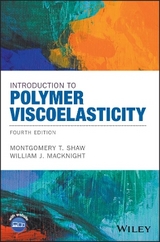
Introduction to Polymer Viscoelasticity
Seiten
2005
|
3rd Edition
Wiley-Blackwell (an imprint of John Wiley & Sons Ltd) (Verlag)
978-0-471-74045-2 (ISBN)
Wiley-Blackwell (an imprint of John Wiley & Sons Ltd) (Verlag)
978-0-471-74045-2 (ISBN)
- Titel ist leider vergriffen;
keine Neuauflage - Artikel merken
Zu diesem Artikel existiert eine Nachauflage
A revised molecular approach to a classic on viscoelastic behavior
Because viscoelasticity affects the properties, appearance, processing, and performance of polymers such as rubber, plastic, and adhesives, a proper utilization of such polymers requires a clear understanding of viscoelastic behavior.
Now in its third edition, Introduction to Polymer Viscoelasticity remains a classic in the literature of molecular viscoelasticity, bridging the gap between primers on polymer science and advanced research–level monographs. Assuming a molecular, rather than a mechanical approach, the text provides a strong grounding in the fundamental concepts, detailed derivations, and particular attention to assumptions, simplifications, and limitations.
This Third Edition has been entirely revised and updated to reflect recent developments in the field. New chapters include:
∗ Phenomenological Treatment of Viscoelasticity
∗ Viscoelastic Models
∗ Time–Temperature Correspondence
∗ Transitions and Relaxation in Polymers
∗ Elasticity of Rubbery Networks
∗ Dielectric and NMR Methods
With detailed explanations, corresponding equations, and experimental methods, supported by real–life applications (as well as the inclusion of a CD–ROM with data to support the exercises), this Third Edition provides today′s students and professionals with the tools they need to create polymers with more desirable qualities than ever.
Because viscoelasticity affects the properties, appearance, processing, and performance of polymers such as rubber, plastic, and adhesives, a proper utilization of such polymers requires a clear understanding of viscoelastic behavior.
Now in its third edition, Introduction to Polymer Viscoelasticity remains a classic in the literature of molecular viscoelasticity, bridging the gap between primers on polymer science and advanced research–level monographs. Assuming a molecular, rather than a mechanical approach, the text provides a strong grounding in the fundamental concepts, detailed derivations, and particular attention to assumptions, simplifications, and limitations.
This Third Edition has been entirely revised and updated to reflect recent developments in the field. New chapters include:
∗ Phenomenological Treatment of Viscoelasticity
∗ Viscoelastic Models
∗ Time–Temperature Correspondence
∗ Transitions and Relaxation in Polymers
∗ Elasticity of Rubbery Networks
∗ Dielectric and NMR Methods
With detailed explanations, corresponding equations, and experimental methods, supported by real–life applications (as well as the inclusion of a CD–ROM with data to support the exercises), this Third Edition provides today′s students and professionals with the tools they need to create polymers with more desirable qualities than ever.
MONTGOMERY T. SHAW, PhD, is the A. T. DiBenedetto Distinguished Professor at the University of Connecticut in Storrs–Mansfield, Connecticut. WILLIAM J. MacKNIGHT, PhD, is the Wilmer D. Barrett Distinguished Professor at the University of Massachusetts Amherst and the co–Principal Investigator for the Center for UMass/Industry Research on Polymers (CUMIRP).
1. Introduction.
2. Phenomenological treatment of viscoelasticity.
3. Viscoelastic models.
4. Time–temperature correspondence.
5. Transitions and relaxation in polymers.
6. Elasticity of rubbery networks.
7. Dielectric and NMR methods.
| Erscheint lt. Verlag | 26.8.2005 |
|---|---|
| Verlagsort | Chicester |
| Sprache | englisch |
| Maße | 184 x 255 mm |
| Gewicht | 752 g |
| Themenwelt | Naturwissenschaften ► Chemie ► Organische Chemie |
| Recht / Steuern ► Wirtschaftsrecht | |
| Technik ► Maschinenbau | |
| ISBN-10 | 0-471-74045-4 / 0471740454 |
| ISBN-13 | 978-0-471-74045-2 / 9780471740452 |
| Zustand | Neuware |
| Informationen gemäß Produktsicherheitsverordnung (GPSR) | |
| Haben Sie eine Frage zum Produkt? |
Mehr entdecken
aus dem Bereich
aus dem Bereich



